Nordics Geospatial Analytics Market Size
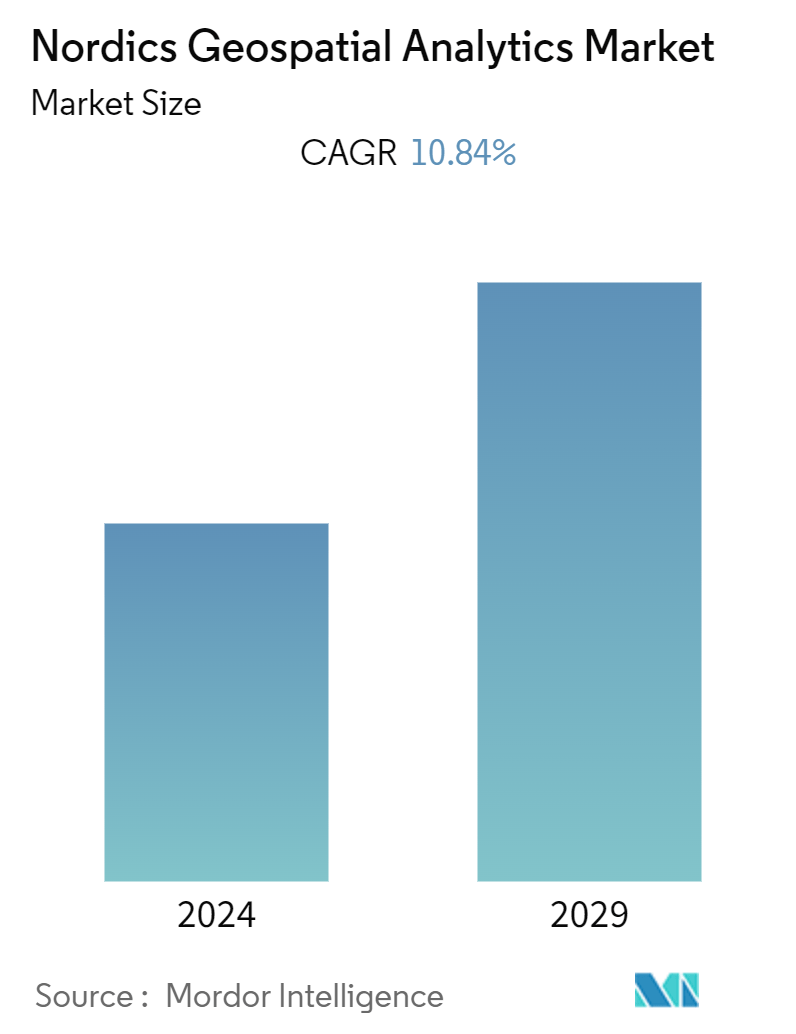
| Study Period | 2019 - 2029 |
| Base Year For Estimation | 2023 |
| Forecast Data Period | 2024 - 2029 |
| Historical Data Period | 2019 - 2022 |
| CAGR (2024 - 2029) | 10.84 % |
| Market Concentration | Medium |
Major Players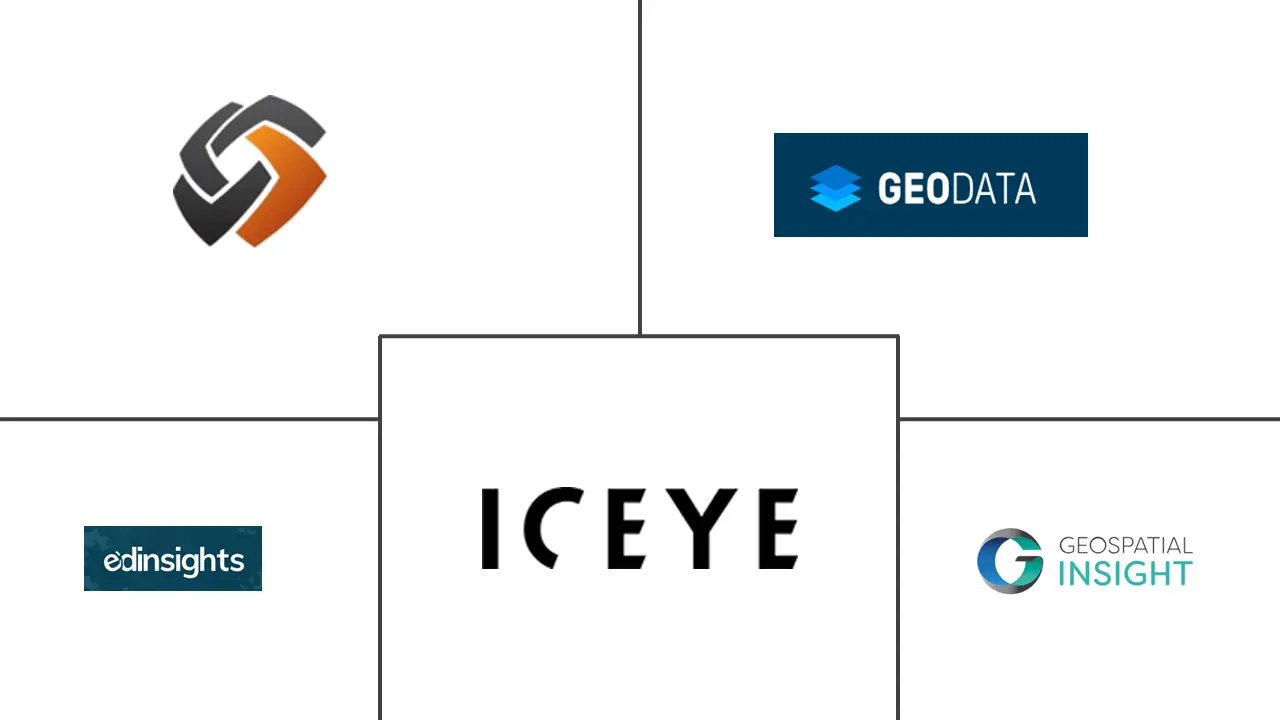
*Disclaimer: Major Players sorted in no particular order |
Nordics Geospatial Analytics Market Analysis
The Nordics Geospatial Analytics Market is expected to register a CAGR of 10.84% during the forecast period.
The growth is majorly attributed to the significant usage of these solutions for better visualization of real-time situations in telecom, military, urban planning, and other applications.
- Geospatial analytics is acquiring, manipulating, and displaying imagery and data from the geographic information system (GIS), such as satellite photos and GPS data. The specific identifiers of a street address and a zip code are used in geospatial data analytics. They are used to create geographic models and data visualizations for more accurate trend modelling and forecasting.
- The growing smart city implementation projects in the region are one of the major driving factors for the market. For instance, despite an interruption in momentum during the pandemic, Stockholm is still on its way to becoming the world's smartest city by 2040. It's a government-declared goal in this city that aligns with the city becoming carbon neutral by 2040. Digital infrastructure, from the Internet of Things to 5G and data centres for edge processing and edge computing, will play a critical role in providing the future's services. As geospatial analytics play a crucial role in providing accurate data, the demand is analyzed to grow.
- Further, the market is driven by the increasing number of AI-based GIS solutions, advances in Big Data Analytics, the growth of smart cities, urbanization, the Internet of Things, and the integration of sensors in all sectors. Companies are able to gain increased insight through AI and machine learning capabilities in combination with spatial data.
- Combining AI and machine learning with geographical solutions saves significant time and resources. It allows the completion of tasks such as picture classification, object identification, Semantic Classification, and instance segmentation. Geospatial Analytics solution providers, as AI and ML technologies improve, may provide clients with more sophisticated Spatial solutions in several business sectors that allow them to be deployed more effectively. Therefore, these factors are analyzed to boost the market growth rate during the forecast period.
Nordics Geospatial Analytics Market Trends
Introduction of 5G to Boost Market Growth
- Geoscience data and strong geographic analyses can substantially contribute to effective telecommunications services in the short and medium term. For instance, geospatial data can play an essential role in the fit-for-purpose planning and optimal deployment of networks and services and help ensure these networks are cost-effective and efficient.
- The use of 5G may also assist in addressing environmental challenges by means of technologies such as location intelligence and digital mapping. Increasing the energy efficiency of 5G, reducing GHG emissions, and using more renewables can be achieved by the Internet of Things' speed, connectivity, and data capacity. 5G could help broaden understanding of and improve decision-making about weather, vegetation, or waste management which is a significant driver for the need for spatial analysis.
- Further, the significant coverage, as indicated in the graph alongside the growing telecom company efforts to boost the coverage, is analyzed to increase the market growth rate during the forecast period. Tele2 and Telenor have set up a joint venture called Net4Mobility. In 2022, Tele2 and Telenor Sweden committed to accelerating the deployment of 5G networks to extend net4mobility's coverage to 90% of the Swedish population by the end of 2023 and in 2024.
- Telia Sweden aims to match the coverage of 5G with that of its 4G network by 2025 in cooperation with a long-standing partner, Ericsson. By 2023, the target of providing coverage for over 90% of the population with 5G services should be achieved; in the medium to long term, it would extend to 90% geographic and 99% global coverage.
- In 2023, the capital region Uusimaa, which includes Finland's capital city Helsinki, had the highest 5G coverage at 51 percent in Finland. Both Pirkanmaa and Kanta-Häme regions had a 34 percent share each. Lapland and Kainuu placed at the bottom, having only a two percent 5G coverage.
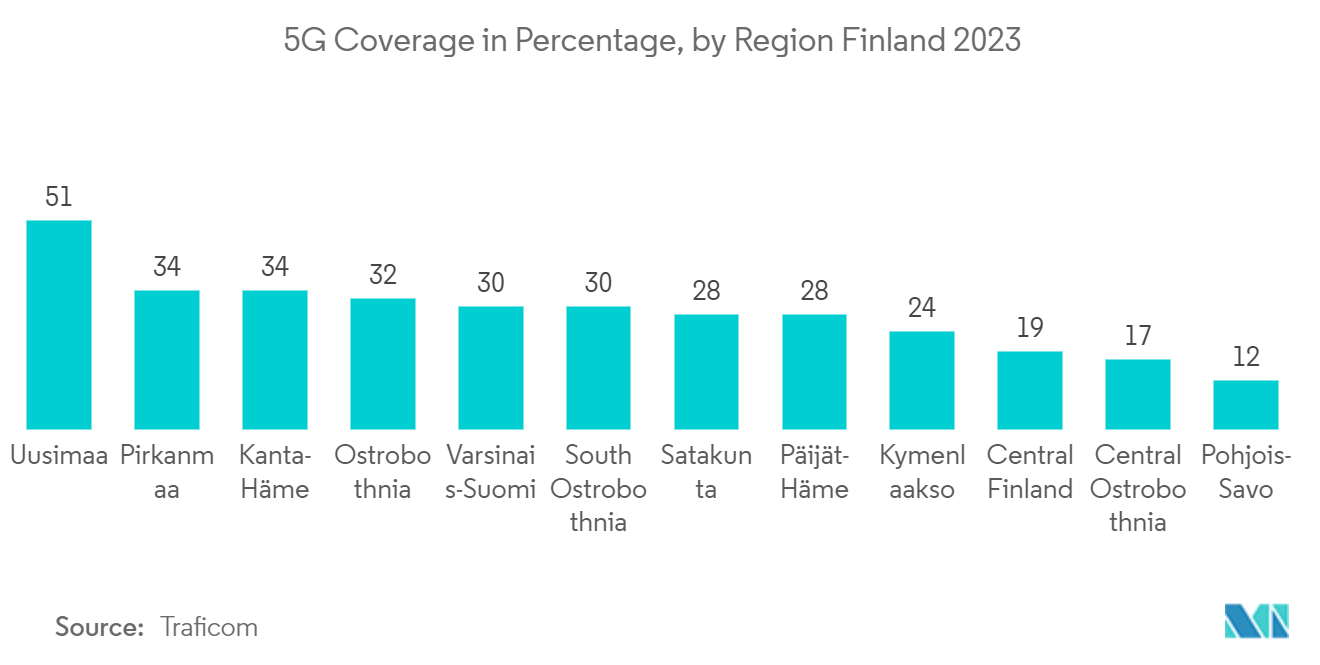
Real Estate and Construction is analyzed to hold a significant share in the market
- The graph indicates that the growing urban population significantly drives the demand for the real estate and construction industry. It is analyzed to boost the adoption of advanced technologies for effective outcomes, thereby contributing to market growth. Geospatial analytics determines the impact of population growth on energy, transport, and housing resources. Planners can visualize large datasets at high speed and scale by using Geospatial Big Data Analytics. It further allows for integrating and cross-filtering data from many sources to oversee factors, including how crime, education, public health, and housing/real estate results differ by location.
- According to Nordic Smart City Network, there are 19 smart cities connected in one smart network in the Nordic countries. Further, the growing emphasis on these cities with respect to climate change is analyzed to boost the construction sector, thereby contributing to the demand for geospatial analytics in the region.
- For instance, in March 2023, In Finland, Climate Cooperation was established between municipalities Vantaa, Kerva, and Jrvenp, as well as several companies, to reduce the region's carbon dioxide emissions. The Finnish Ministry for the Environment finances the project, while Vantaa City has acted as coordinator, and nearby Kerava and Jrvenp municipalities have been cooperating partners. It is an illustrative case of how the concept of Smart Cities has been promoted within the Helsinki Region, both economically as well as environmentally.
- As smart cities adopt geospatial infrastructure and all the understandings that come with it to create data-driven conclusions to serve the public better, the growth of these smart cities driving the demand for construction to accommodate the growing urban population in the region is analyzed to boost the market growth rate during the forecast period.
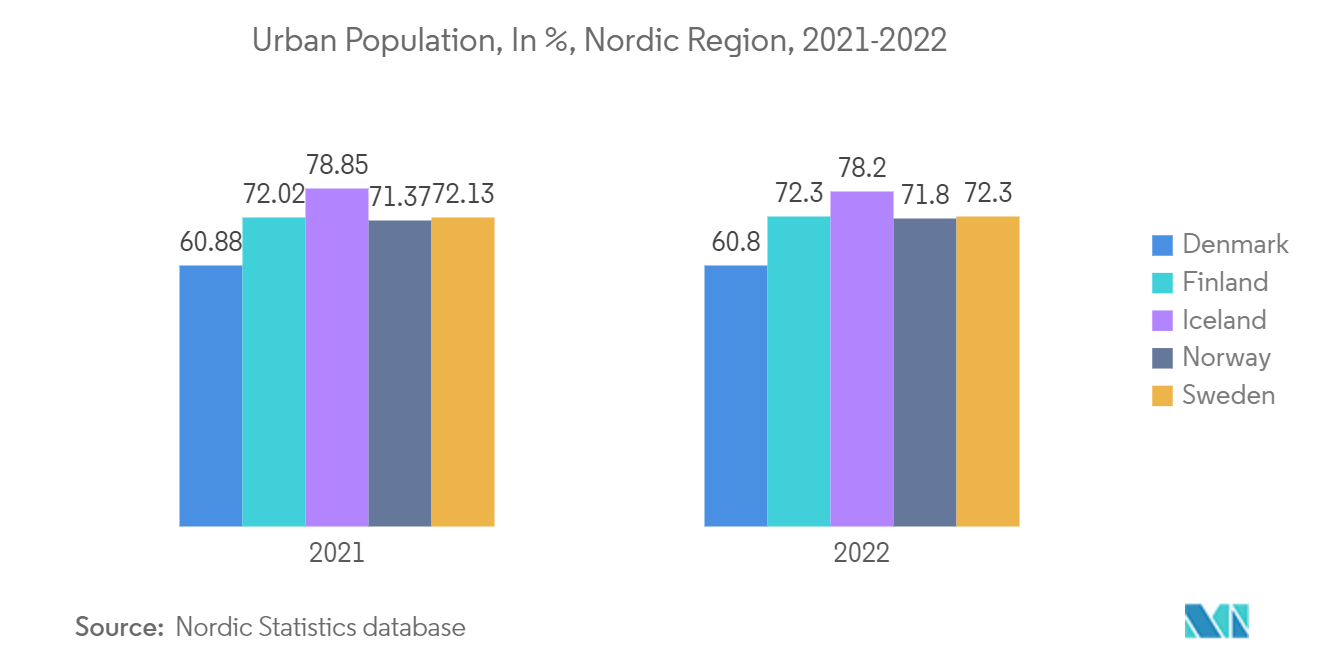
Nordics Geospatial Analytics Industry Overview
The market for Geospatial analytics in the Nordic region is analyzed to be semi consolidated, with several players offering solutions in the region. Also, several startups have been observed in the region. Moreover, the growing strategic developments, such as investments and collaborations, are analyzed to bolster the market during the forecast period.
In April 2022, ICEYE, a Synthetic Aperture Radar (SAR) data and NatCat solutions provider, announced that it received a USD 136 million Series D funding round, primarily led by investor Seraphim Space. The new capital will enable ICEYE to expand its innovative natural catastrophe solution offering and further develop its leading satellite constellation and technologies, thereby reducing access time and increasing the visit frequency of its satellites. In addition, the company will make further investments in its expansion through services such as Analytics, including Artificial Intelligence and Machine Learning.
Nordics Geospatial Analytics Market Leaders
-
Nordic Geocenter
-
Geodata AS
-
ICEYE
-
Geospatial Insight
-
ED Insights
*Disclaimer: Major Players sorted in no particular order
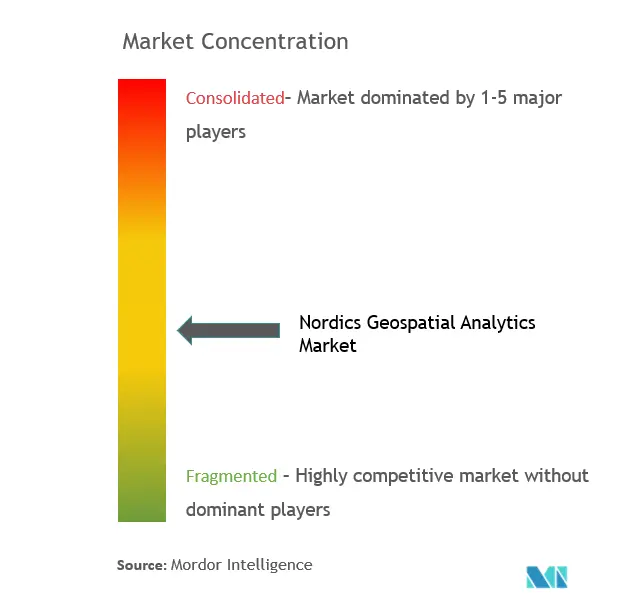
Nordics Geospatial Analytics Market News
- May 2024 - The security environment in Europe and around the world is dramatically shifting, and that’s spurring NATO to prioritize AI and other technological tools to bolster its geospatial intelligence enterprise, according to a top official. Spatial deep learning techniques have become significantly potent, thanks to unparalleled computational capabilities. Utilizing these advancements with extensive sets of images or geographical information will enhance the process of generating intelligence by enabling functions such as automated change identification. This will benefit various areas such as regions of focus, economic analysis, maritime security, space and cyber event analysis, among other possibilities.
- January 2024 - WHO/Europe marked the launch of the WHO European Geospatial Coordination Hub in Istanbul, Türkiye, on 15 November 2023. Its goal is to empower countries in the WHO European Region to effectively utilize Geographic Information Systems (GIS) for faster and more informed public health decisions. Geospatial technology, in the form of GIS, enables the visualization and analysis of data on a map. Within the health sector, GIS can play a vital role by supporting evidence-based planning and decision-making, aiding in emergency response, and helping to forecast and analyze health trends over time.
Nordics Geospatial Analytics Market Report - Table of Contents
1. INTRODUCTION
1.1 Study Assumptions and Market Definition
1.2 Scope of the Study
2. RESEARCH METHODOLOGY
3. EXECUTIVE SUMMARY
4. MARKET INSIGHTS
4.1 Market Overview
4.2 Industry Attractiveness - Porter's Five Forces Analysis
4.2.1 Bargaining Power of Buyers
4.2.2 Bargaining Power of Suppliers
4.2.3 Threat of New Entrants
4.2.4 Threat of Substitutes
4.2.5 Intensity of Competitive Rivalry
4.3 Industry Value Chain Analysis
4.4 Macro Economic Factors having an impact on the market
5. MARKET DYNAMICS
5.1 Market Drivers
5.1.1 Increase in Adoption of Smart City Development
5.1.2 Introduction of 5G to Boost Market Growth
5.2 Market Restraints
5.2.1 High Costs and Operational Concerns
6. MARKET SEGMENTATION
6.1 By Type
6.1.1 Surface Analysis
6.1.2 Network Analysis
6.1.3 Geo-visualization
6.2 By End-user Vertical
6.2.1 Agriculture
6.2.2 Utility and Communication
6.2.3 Defense and Intelligence
6.2.4 Government
6.2.5 Mining and Natural Resources
6.2.6 Automotive and Transportation
6.2.7 Healthcare
6.2.8 Real Estate and Construction
6.2.9 Other End-user Verticals
7. COMPETITIVE LANDSCAPE
7.1 Company Profiles
7.1.1 Nordic Geocenter
7.1.2 Geodata AS
7.1.3 ICEYE
7.1.4 Geospatial Insight
7.1.5 ED Insights
7.1.6 Geocap AS
7.1.7 Karttjenester
7.1.8 Mapillary
7.1.9 Hexagon AB
- *List Not Exhaustive
8. INVESTMENT ANALYSIS
9. MARKET OPPORTUNITIES AND FUTURE TRENDS
Nordics Geospatial Analytics Industry Segmentation
Geospatial Analytics adds timing and location to conventional data types and creates data visualizations. Maps, graphs, statistical data, and cartograms showing historical or current change may be included in these visualizations. A clearer picture of events is possible by means of this further context. This would allow predictions to be executed faster, simpler, and more accurately.
The Nordics geospatial analytics market is segmented by type (surface analysis, network analysis, geovisualization), end user vertical (agriculture, utility and communication, defence and intelligence, government, mining and natural resources, automotive and transportation, healthcare, real estate, and construction). The market sizes and forecasts are provided in terms of value (USD) for all the above segments.
| By Type | |
| Surface Analysis | |
| Network Analysis | |
| Geo-visualization |
| By End-user Vertical | |
| Agriculture | |
| Utility and Communication | |
| Defense and Intelligence | |
| Government | |
| Mining and Natural Resources | |
| Automotive and Transportation | |
| Healthcare | |
| Real Estate and Construction | |
| Other End-user Verticals |
Nordics Geospatial Analytics Market Research Faqs
What is the current Nordics Geospatial Analytics Market size?
The Nordics Geospatial Analytics Market is projected to register a CAGR of 10.84% during the forecast period (2024-2029)
Who are the key players in Nordics Geospatial Analytics Market?
Nordic Geocenter, Geodata AS, ICEYE, Geospatial Insight and ED Insights are the major companies operating in the Nordics Geospatial Analytics Market.
What years does this Nordics Geospatial Analytics Market cover?
The report covers the Nordics Geospatial Analytics Market historical market size for years: 2019, 2020, 2021, 2022 and 2023. The report also forecasts the Nordics Geospatial Analytics Market size for years: 2024, 2025, 2026, 2027, 2028 and 2029.
Nordics Geospatial Analytics Industry Report
Statistics for the 2024 Nordics Geospatial Analytics market share, size and revenue growth rate, created by Mordor Intelligence™ Industry Reports. Nordics Geospatial Analytics analysis includes a market forecast outlook to for 2024 to 2029 and historical overview. Get a sample of this industry analysis as a free report PDF download.



